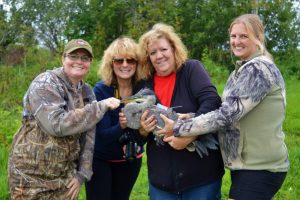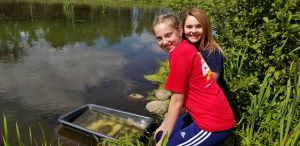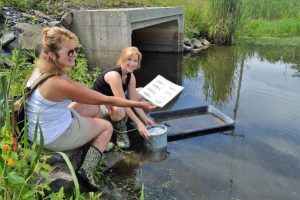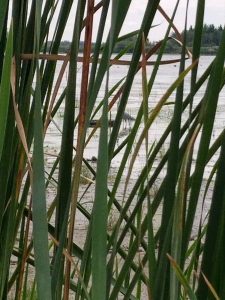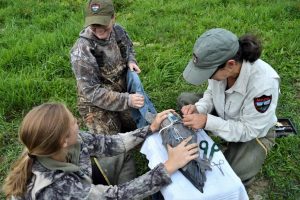September 7, 2018 at 3:15 pm
Great blue heron named "Easton’s Baby Blue" with Amanda DeMusz (IFW biologist), Vonda Lavway (2nd Grade Teacher, Easton), Earlene Lawrence (Ed Tech, Easton), and Brittany Currier (IFW biologist).
On an otherwise quiet Sunday morning before dawn, our headlamps lit the way through cattails and boot-sucking mud as we carried a bucket of baitfish and tubs of traps to a bin set in the shallows of Christina Reservoir in Aroostook County. Just the day before, our game camera caught a great blue heron feeding from our bait bin, so we were ready to try our luck at capturing and tagging the heron for research purposes.
Easton Middle School students, Jenna Cochran and Nickie Deschaine, checking on the bait bin Photo by Ellen Trask.
Since 2016, with the help of local school teachers and their students, IFW has tagged seven adult great blue herons with solar-powered GPS transmitters. These units collect fine-scale location information as often as every five minutes. Purchased with funding from the Maine Outdoor Heritage Fund, the transmitters last multiple years and provide data throughout the year about movement patterns and habitat use during nesting, migration, and wintering periods. Students have been following the herons online and learning about the habitats they require. The tagged herons are part of a larger study led by the non-profit group, 1000 Herons, and join 13 herons and egrets tagged in five other states.
Easton teachers, Vonda Lavway (2nd grade) and Ellen Trask (grades 7-12), making sure they are only using legal baitfish to stock the bait bin. Photo by Earlene Lawrence.
Capturing a great blue heron requires first luring it to a specific spot in a wetland by providing a bin of live fish for it to feed on. Once it gets used to its easy meal and feeds from the bin frequently, biologists set up two dozen modified foothold traps around the bin and sit and wait in a blind for a heron to come in and step on a trap. For weeks, teachers and students from Easton School System and Ashland High School had been helping us by setting out bait bins, keeping them stocked with live baitfish caught with minnow traps, and monitoring the bins with game cameras. It was a friendly race between the two schools to see who could get a heron feeding from a bin first. This time, Easton prevailed and within an hour of sitting in a blind we had a great blue heron in hand. Two teachers from Easton joined us that morning and were beyond ecstatic to witness the event!
View from the blind. Can you find the great blue heron? Photo by Brittany Currier.
This great blue heron is unique among all the others that have been tagged thus far because it is a young-of-the-year, hatched this past spring. All our other tagged herons have been captured as adults and thus we do not know their ages. It will be exciting to see how this heron’s movements change as it progresses from juvenile to adult. The students at the Easton School System have adopted this high-tech wader, and thus have naming rights. They voted to name it “Easton’s Baby Blue,” because it is our only juvenile. Their first vote was Big Blue after their favorite chant at sports games (“Go Big Blue!”), but that was already taken by a heron tagged in 2014 in North Carolina. Easton’s Baby Blue is also unique in that it originated much further north than all the others tagged so far. Great blue herons occur statewide in Maine, but we currently only know of four active nesting colonies in all of Aroostook County. However, every August when IFW conducts duck banding on Christina Reservoir and Lake Josephine in the Presque Isle area, herons (mostly juveniles) abound. Where do all the herons come from? We are hoping Easton’s Baby Blue helps answer this question among many others, and we look forward to working with Easton students to uncover some of this bird’s mysteries.
IFW biologists, Brittany Currier, Amanda DeMusz, and Danielle D’Auria, attach the GPS transmitter as a backpack. The heron’s head is kept covered to keep it calm. Photo by Earlene Lawrence.
Easton’s Baby Blue joins three other Maine herons whose transmitters are still working and providing data: Cornelia from Gray, and Nokomis and Warrior from Palmyra. Cornelia and Nokomis have been tagged since 2016 and winter in the Bahamas and Haiti, respectively. We can’t wait to find out where Warrior and Easton’s Baby Blue migrate to this fall. You can follow all four of our tagged herons by following these instructions.
 Close up of Easton’s Baby Blue. As a juvenile, it has an all gray crown compared to the black and white feathers on an adult. Photo by Vonda Lavway.
Close up of Easton’s Baby Blue. As a juvenile, it has an all gray crown compared to the black and white feathers on an adult. Photo by Vonda Lavway.
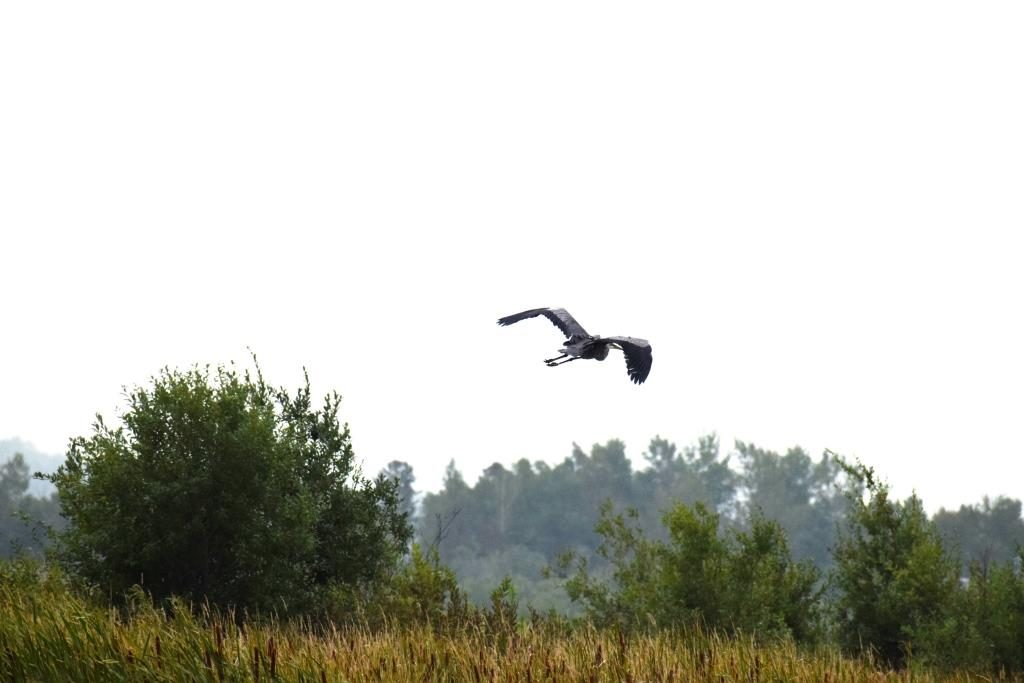 Release of Easton’s Baby Blue at Christina Reservoir, Aroostook County. Photo by Vonda Lavway.
Release of Easton’s Baby Blue at Christina Reservoir, Aroostook County. Photo by Vonda Lavway.
